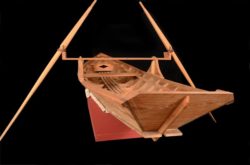Raymond Sedatol
A native of the Atchafalaya Basin, master boat builder Raymond Sedatol constructed traditional watercraft such as pirogues and rowing skiffs in the manner of his Cajun ancestors.

Courtesy of Stephen Legendre
Skiff (stern view). Sedatol, Raymond (Artist)
A native of the Atchafalaya Basin, master boat builder Raymond Sedatol constructed traditional watercraft such as pirogues and rowing skiffs in the manner of his Cajun ancestors. Reflecting European and Acadian influences, his vernacular functional forms underscore the intimate, enduring relationship that the people of Acadiana’s coastal parishes have enjoyed with the region’s abundant waterways. Sedatol received national recognition for his craftsmanship and helped to inspire a revival of traditional wooden boatbuilding in the state.
Sedatol began his lifelong engagement with native hardwoods in the vast cypress-tupelo swamplands of southeast Louisiana. Hailing from Pierre Part, a small town in Assumption Parish established by Acadian exiles in the eighteenth century, he began working at a young age in the Atchafalaya Basin’s floating logging camps. There he spent more than thirty years as a timber-cutter before taking up woodcarving and carpentry.
Sedatol learned to build boats from his grandfather and other local builders at a time when many Cajuns mastered the craft, and small wooden vessels offered the only mode of transportation in the region’s expansive swamps. Using virgin cypress and sinker logs pulled from the swamp during his regular scouting trips of the wetlands, Sedatol built a variety of indigenous boats for local fishermen and loggers, but his Creole rowing skiffs and pirogues remained his most popular creations.
The Creole rowing skiff derives from one of several variations of the ancient esquif, a small open utility boat with pointed bow used in France. Sedotal’s skiffs more closely resemble those from southern France used on modest interior bodies of water; it is smaller and lighter than similar indigenous watercraft such as the haul-seine skiff, Pontchartrain skiff, or Barataria skiff. It measures approximately sixteen feet in length and features a high V-shaped stern and a yoke, or “joug,” which raises the oars above the gunwales, or upper side edges. The Creole skiff is rowed by a standing oarsman who faces forward toward the bow, the only North American boat operated in such a manner. Sedatol often jokingly explained the origins of this distinction: “A Cajun doesn’t want to row backwards. He wants to know where he’s going, not where he’s been.”
Throughout the nineteenth and early twentieth century, Creole rowing skiffs were popular for individual and group travel, especially on open bayous and lakes. With the advent of the gasoline engine, however, Creole skiffs became increasingly rare and largely limited to the vicinity of Pierre Part. Since the mid-1980s, there has been a minor revival in this style of watercraft, encouraged through the efforts of Sedatol and other traditional boat builders.
Sedatol also gained recognition for his handcrafted pirogues, sharply tapered flat-bottomed boats built for the shallow, densely forested marshes of south Louisiana. Originally narrow dugouts made from whole cypress logs, the deforestation of many of the state’s old growth forests at the turn-of-the-century limited the availability of adequately sized trees and, in turn, forced builders to utilize cypress planks and, later, marine plywood with cypress stripping. Sedatol’s pirogues typically measured from twelve to sixteen feet in length and were used for hunting, trapping, and fishing across the Atchafalaya Basin.
In the late 1980s, Sedatol began carving waterfowl from wood, originally making decoys but later decorative pieces, as well. He was also known as a lively raconteur, knowledgeable about folk healing and other aspects of tradition Cajun culture. Sedatol served as a master boat builder for the Louisiana Folklife Apprenticeship Program. He also helped sustain the Atchafalaya Basin’s vernacular woodworking traditions by supplying other boat builders with virgin cypress lumber, pre-cut head blocks (bow stems), and boat ribs as well as providing fellow decoy carvers with blocks from felled tupelo gum trees.
Sedatol demonstrated boat building at the 1983 and 1988 Smithsonian Festival of American Folklife in Washington, D.C., and at major festivals across Louisiana, including the 1984 World Exposition in New Orleans, the Louisiana Folklife Festival, New Orleans Jazz and Heritage Festival, and the Natchitoches Folk Festival. Sedatol’s boats have been exhibited by the Smithsonian Institution, the Center for Traditional Louisiana Boat Building at Nicholls State University in Thibodaux, Jean Lafitte National Historic Park and Preserve in New Orleans, and the Vermilionville Living History Museum and Folklife Park in Lafayette, Louisiana. In 2000, one of Raymond’s Creole skiffs was featured at the Fêtes Maritimes de Douarnenez (near Brest, France).
